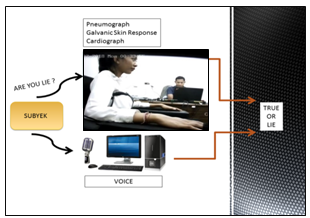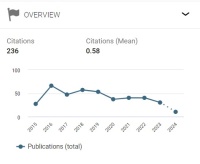Deteksi Kebohongan Berdasarkan Fitur Fonetik Akustik
Abstract
Abstract - This study aims to statistically analyze the parameters of acoustic phonetic features, namely: pitch, formant and intensity as indicators of psychological pressure from a person's lying or honest voice. The strength of this research is using the "true experimental" model and assessing a person's lying / honest voice in real time parallel to the polygraph test. The study was conducted on 6 subjects (3 couples) which were divided into 2 groups, namely the control group that was not treated, and the treatment group who received treatment with instructions to take money in a wallet on the table and was asked to lie not to take the money in question. . Voice samples are the answers to “No” to the relevant and comparison questions on the examined subjects on the polygraph test. The Praat software was used for feature extraction and data analysis using SPSS with the Paired Samples T Test and the Wilcoxon Sign Rank Test for different tests. Based on the results of the statistical analysis of acoustic phonetic features, a scoring system is proposed by setting a score (+1) when the results of Ho's statistical analysis are accepted (Sig value> 0.05) or in other words there is no difference between the formant, intensity and pitch values of the answer to the word "no" to the comparison question. with the answer to the word "no" in the relevant question. And vice versa set a score (-1) when the results of statistical analysis Ho is rejected (Sig value <0.05) or in other words there are differences in the value of formant, intensity and pitch of the answer to the word "no" to the comparison question with the answer to the word "no" to the relevant question. The final conclusion is that the total score (+) indicates honest and the total score (-) indicates a lie. Based on the total value of statistical analysis, the formant features are known to be very significant for detecting someone's lies, because in this study they have a 100% probability of successfully detecting lies, while the intensity and pitch features are less significant for detecting lies because they only have a 66.666% probability of successfully detecting lies 33.333%.
Downloads
References
[2] Neeraj Bhagel, dkk., August 2020. ”Truth Identification From EEG Signal By Using Convolution Neural Network : Lie Detection”, IEEE. DOI: 10.1109/TSP49548.2020.9163497.
[3] M. Ashadur Rahman, dkk., January 2017. “Lie Detection From Fnir Signal And Neuro Image”, IEEE. DOI: 10.1109/ICTEA.2012.6462897.
[4] R. Cakmak, Akram M. Zeki, April 2015. “Neuro Signal Based Lie Detection”, IEEE. DOI: 10.1109/IRIS.2015.7451606.
[5] Birender Singh, dkk., November 2015. “Lie Detection Using Image Processing”, IEEE.DOI: 10.1109/ICACCS.2015.7324092.
[6] A. Freire, M. Eskritt, and K. Lee, 2004 “Are Eyes Windows To A Deceiver's Soul? Children's Use Of Another's Eye Gaze Cues In A Deceptive Situation", Developmental psychology, vol. 40, no. 6, p. 1093.
[7] Michel Owayjan, dkk., February 2013. “The Design And Development Of A Lie Detection System Using Facial Micro-Expressions”, IEEE. DOI: 10.1109/ICTEA.2012.6462897.
[8] D. Matsumoto, H.S. Hwang, Juni. 2011 “Evaluating Truthfulness And Detecting Deception” In press, FBI Law Enforcement Bulletin.
[9] A. Vrij, 2008. “Detecting Lies and Deceit: Pitfalls and Opportunities”, Chichester: Wiley.
[10] N. Sebanz and M. Shiffrar, 2009 “Detecting Deception In A Bluffing Body: The Role Of Expertise" Psychonomic bulletin & review, vol. 16, no. 1, pp. 170-175.
[11] M. Gabela, February 2013. “Evaluation Of The Questions Used In A Polygraph Test”, Submitted In Accordance With The Requirements For The Degree Of Magister Technologiae In The Subject Forensic Investigation At The University Of South Africa.
[12] Nelson, dkk., 2011. Using The Empirical Scoring System. Polygraph, 2011, 40 (2).
[13] Charles R. Honts, Juni. 1994 "Psychophysiological Detection Of Deception", Psychological Science, Volume 3 Number 3.
[14] Adler, Michael J., 2009. "Detecting Deceptive Reaksises In Sex Offenders: A Comparison Of Layered Voice Analysis (LVA) And The Polygraph" Working Paper, Counseling and Consultation Services, Inc. Limestone, TN.
[15] Fransisco Lacerda. 2009. “LVA-Technology The Illusion Of Lie Detection” Proceedings Fonetik, Department of Linguistics, Stockholm University.
[16] Hopkins C.S., R. J. Ratley, D. S. Benincasa, J. J. Grieco, 2005 "Evaluation of Voice Stress Analysis Technology" US Air Force Research Laboratory, under contract to the US National Institute for Justice. - Rome, NY, IEEE. DOI: 10.1109/HICSS.2005.254.
[17] Frank Horvath Ph.D. 2002. “The Accuracy Of Auditors And Layered Voice Analysis (LVA) Operators’Judgments Of Truth And Deception During Police Questioning”, Journal of Forensic Sciences. Vol. 58, Issue 2.
[18] Christin Kirchhübel & David M Howard, July 9-14. 2011 “Investigating The Acoustic Characteristics Of Deceptive Speech” Engineering Psychology and Cognitive Ergonomics: 9th International Conference, EPCE 2011, Held as Part of HCI International 2011, Orlando, FL, USA,. Proceedings (pp.28-37).
[19] Savita Sondhi, dkk., 2016. “Voice Analysis For Detection Of Deception Knowledge, Information And Creativity Support Systems (KICSS)”, IEEE. DOI: 10.1109/KICSS.2016.7951455.
[20] Nazir, M. 2003. “Metode Penelitian”. Jakarta: Ghalia Indonesia.
[21] Dahlan, M.S. 2009. “Statistik untuk Kedokteran dan Kesehatan”, Edisi 4 (Deskriptif, Bivariat dan Multivariat, dilengkapi Aplikasi dengan Menggunakan SPSS). Jakarta: Salemba Medika.
[22] Idrus Alwi. “Kriteria Empirik Dalam Menentukan Ukuran Sampel Pada Pengujian Hipotesis Statistika Dan Analisis Butir”, Jurnal Formatif 2(2): 140-148 ISSN: 2088-351X.


This work is licensed under a Creative Commons Attribution-NonCommercial-NoDerivatives 4.0 International License.

This work is licensed under a Creative Commons Attribution 4.0 International License




